Abstract
Drones offer significant safety and security advantages by enhancing situational awareness across various fields. However, realizing these benefits hinges on well-designed drone systems. This study builds upon previous research on drone deployment challenges and proposes the Drone Safety and Security Surveillance System (D4S). D4S aims to standardize similar drone-based systems, enhancing situational awareness and supporting decision-making processes. While initially tailored for safety and security, D4S holds potential for broader applications. Two system architectures have been proposed and evaluated with positive feedback from safety and security professionals. D4S has the potential to revolutionize safety practices, improve situational awareness, and facilitate timely decision making in critical scenarios.
Keywords:
drones; safety; security; surveillance; technology acceptance model; UAVs; user acceptance 1. Introduction
1.1. Unmanned Aerial Vehicles (UAVs)
Drones, also known as unmanned aerial vehicles (UAVs), have gained increasing popularity due to their wide range of applications. These aircraft can vary in size and complexity, from small, lightweight devices to larger systems equipped with advanced technology. Drones possess the capability to perform diverse tasks and are being utilized across various industries and sectors [1]. One of the primary advantages of drones is their ability to access and navigate areas that are challenging or perilous for humans. In search-and-rescue operations, drones can locate missing persons in remote or hazardous locations, providing critical aid to rescue teams. Drones equipped with thermal cameras and infrared sensors can detect heat signatures, making them invaluable tools in emergency situations [2].
The agricultural sector has also harnessed the potential of drones. By utilizing sensors and imaging technology, drones can monitor crops, detect crop health, and provide precise information on irrigation needs. This allows farmers to optimize their crop yield, minimize resource usage, and enhance overall crop management. Drones equipped with spraying systems can also be employed for targeted pesticide application, reducing the need for manual labor and minimizing environmental impact [3].
Drones have found extensive use in the commercial sector, particularly in the delivery industry. Companies like Amazon and UPS are actively exploring the use of drones for package delivery, offering the potential to significantly reduce delivery times and costs. Moreover, drones have demonstrated their efficacy in infrastructure inspections, such as monitoring pipelines, power lines, and bridges. They can conduct visual inspections and collect data without requiring expensive equipment or posing risks to human lives [4].
In the media and entertainment industry, drones have revolutionized aerial cinematography [1]. Equipped with high-resolution cameras and stabilizing technology, drones have expanded creative possibilities for filmmakers and photographers by capturing stunning aerial footage and providing unique perspectives in film production, sports coverage, and event photography [1].
However, as the prevalence of drones increases, comprehensive research and regulatory frameworks are necessary to ensure their safe and efficient integration into the global airspace. Critical considerations such as privacy, security, and airspace management need to be addressed to prevent misuse and ensure public safety. The development of technical requirements and standards for drone design and operation is vital to minimize the risk of accidents and collisions with other aircraft [5].
Regulatory bodies and aviation authorities worldwide are actively working on implementing guidelines and regulations for drone operations, including the Federal Aviation Administration in the US. These regulations encompass drone registration, pilot certification, flight restrictions, and airspace coordination. The establishment of clear rules and standards enables effective mitigation of potential risks associated with drone operations while harnessing their benefits [6]. However, to ensure their safe and efficient integration into the global airspace, further research is required to establish robust regulatory frameworks and technical requirements so that each country and each sector might benefit from drones. Through such efforts, drones can be effectively integrated, unlocking their full potential for the betterment of society [7,8,9].
1.2. Drone Applications in Civilian Safety and Security Operations
Systematic and in-depth reviews of 45 publications exploring the use of civilian drones in safety applications to understand the functionality and applications of drones in the civilian domain demonstrated the significant potential of civilian drones in various safety applications [7,8,9]. These included utilizing security cameras to ensure the safety of residential properties, with the majority of such applications relying on a global positioning system (GPS) as the primary means of location sensing and incorporating cameras into their systems [10,11]. Additionally, more than 50% of applications integrated advanced sensors and software to enable advanced functionalities [11]. However, the systematic analysis also identified two important areas for which the number of publications or research papers is limited: smart cities and mega sporting events [9]. Figure 1 depicts a summary of the review findings, providing a comprehensive overview of the diverse applications of drones in safety and security matters within healthcare, engineering, public, and environmental and urban sectors [9]. It showcases the wide range of applications drones have in these domains.
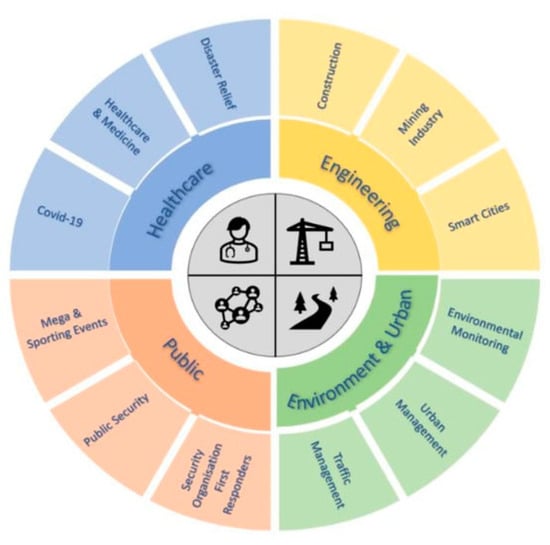
Figure 1.
Drone applications in safety and security [9].
It is important to note that drone technology is still evolving [10]. Despite the numerous opportunities UAVs offer, several challenges need to be addressed to ensure the safe, secure, and effective deployment of drone applications. These challenges include privacy and security concerns [11], the energy restrictions of onboard batteries [10], and the establishment of civilian UAV deployment frameworks in line with international efforts endorsed by the International Civil Aviation Organization (ICAO) [8]. The utilization of drones for surveillance and safety and security applications can significantly contribute to enhancing situational awareness and facilitating dynamic decision making.
A recent study compared the effectiveness of fixed and drone cameras in surveillance imaging, with the goal of identifying ways to improve situational analysis for better risk management [12]. The study’s findings revealed that safety and security professionals acknowledged the limitations of relying solely on fixed cameras and demonstrated heightened situational awareness when utilizing drone surveillance. They also expressed positive attitudes towards adopting surveillance drones for mega sporting events. Furthermore, the study introduced a model for drone surveillance scenario analysis specifically designed to support dynamic decision making. This model has been carefully developed and aligned to effectively integrate drone surveillance, elevating situational awareness not only for mega sports events but also for similar applications across various contexts.
As illustrated in Figure 2, incorporating drone surveillance as a means of environmental sensing aligns with the situational awareness model and is a crucial element of the first level in the Endsley model [12], involving the reception of elements present in the environment. This improvement in environmental sensing results in enhanced inputs for the other two levels: understanding the current situation and projecting future status. Such integration facilitates more efficient dynamic decision making, which is essential in safety and security operations.

Figure 2.
Drone surveillance situational awareness model for dynamic decision making [12].
Based on the findings from the systematic review highlighting the increasing utilization of drones in civilian safety and security applications, alongside the demonstrable effectiveness of the proposed Drone Surveillance Situational Awareness model for dynamic decision making, it is apparent that a unified structural approach is lacking for employing drones in specific civilian safety and security contexts.
Therefore, this paper’s major contribution is the establishment of functional and systems architectures for civilian drone safety and security systems. Such architectures would streamline the development process of these applications and promote efficient system design, development, and maintenance. In addition, the paper contributes to the creation of a standardization platform for comparable drone-based systems aimed at enhancing situational awareness and providing support for dynamic decision making or as a decision support system.
The rest of the paper is organized as follows: section two details the materials and methods, the functional architecture, the systems architecture, the prototype development, the operational concepts, and the evaluation method; section three presents the results from the prototype test mission and the evaluation analysis; and section four covers the discussion.
2. Materials and Methods
2.1. System Development Life Cycle (SDLC)
To achieve the goal of establishing a Drone Safety and Security Surveillance System (D4S) prototype, this study used the system development life cycle (SDLC) methodology, also known as the “application development life cycle”. This is a process for planning, creating, testing, and deploying an information system (Figure 3). SDLC is commonly used in academia and industry within different fields of systems engineering software development and other business activities. It enables a simple and well-known step-by-step process, from the basic identification of project requirements through the design, deployment, and evaluation phases [13].
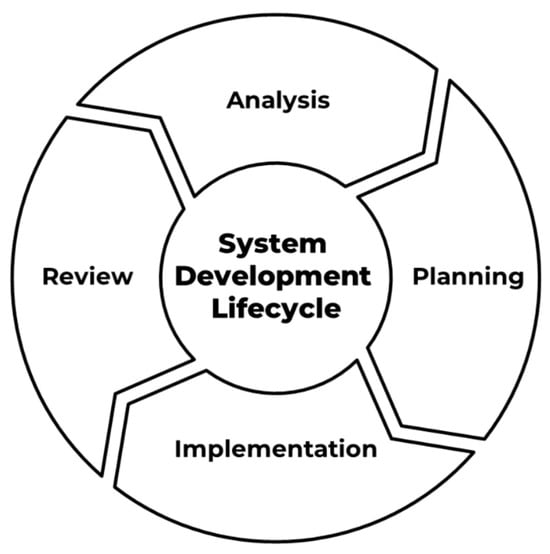
Figure 3.
System development life cycle (SDLC) [13].
2.2. System Prototype
2.2.1. Design Method
Since the system prototype is only for use within this research project and it is not intended to be deployed and tested fully in real life, the iterative SDLC method was determined to be the most suitable to follow to establish the system (Figure 4). It expedited the creation of the first system version at very low cost for testing and evaluation and thereby the identification of required improvements [14].
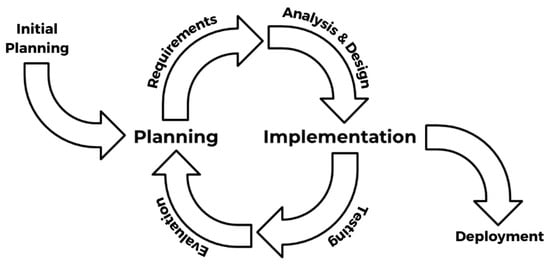
Figure 4.
Iterative SDLC method [14].
2.2.2. Evaluation Method
In the evaluation of the prototype by key stakeholders, we employed the Technology Acceptance Model (TAM) [15], depicted in Figure 5. The TAM serves as a robust framework for elucidating the factors that influence individuals’ acceptance of computer technology [16]. TAM is prolifically used in technology acceptance studies and is acknowledged to be versatile and applicable to diverse end-user computing technologies and demographics. The fundamental tenets of TAM encompass two pivotal concepts: Perceived Usefulness (PU) and Perceived Ease of Use (PEoU).

Figure 5.
Technology acceptance model [16].
Perceived Usefulness (PU) encapsulates a user’s conviction that a given technology will enhance their job performance. It essentially hinges on a user’s belief in the technology’s capacity to enhance job performance, providing a tangible and measurable benefit in their professional tasks.
Perceived Ease of Use (PEoU) pertains to a user’s subjective assessment of the simplicity or complexity associated with utilizing a particular technology. It intersects with various technical, practical, psycho-social, and other contextual factors instrumental in shaping users’ perceptions of the ease or difficulty associated with navigating and utilizing a technology effectively in given situations.
It is imperative to highlight the interconnected nature of these concepts, as both PU and PEoU affect user acceptance and use of technology, as users are more likely to embrace technology when they find it to be user-friendly and effective to achieve their aims.
Since the proposed D4S can be considered to be a decision support system (DSS), a validated evaluation model was adapted in this study in order to provide a correlation between the two approaches for concrete evaluation outcomes. TAM evaluation questions typically obtain feedback on the four elements of PU, PEoU, behavioral intention to use (BI2U), and usage with construct items (as listed in Table 1). This was followed by further analyses according to the aligned model, based on the decision support system evaluation methodology [17]. This revised TAM model for DSS, which was initially presented by Money and Turner [18] and then extended by subsequent research [17], measures users’ attitudes towards the adoption of decision support systems in order to enhance the decision-making process. The key objective was to study end users’ attitudes towards the usage of the new D4S through testing identified study hypotheses listed in Table 2 [17] in order to identify relationships between PU and PEoU and users’ BI2U and usage of the new system.

Table 1.
Construct items [authors].

Table 2.
Adopted hypotheses [17].
2.2.3. Identifying Requirements and Functional Architecture
In system development, a systematic review can help identify the key requirements for a new system by gathering and analyzing existing research, user feedback, and other relevant data. After completing a systematic review, the findings can be used to develop a list of requirements for the system being developed [19]. These requirements should be specific, measurable, and aligned with the goals of the project. This list of requirements informs the rest of the SDLC methodology.
The requirement-gathering phase is critical to the success of the entire system development process. By using a systematic review to inform this phase, one can ensure that the requirements are based on sound evidence and are aligned with the needs of users and stakeholders. Therefore, a previous systematic review study was conducted [9], which included 45 publications presenting previous efforts to use civilian drones in safety and security applications. The review’s findings revealed that drones with basic sensors (for GPS and cameras), advanced sensors, and advanced software were commonly used. As shown in Figure 6, 71% of the reviewed studies used basic sensors for GPS, and 64% used basic camera sensors, while over half used advanced sensors (51%) and advanced software (56%). Based on these insights from existing deployments, two versions of the D4S are proposed: the Basic-D4S (B-D4S) and the Advanced/Assisted-D4S (A-D4S). The basic version of the system has been designed to enable quick deployment with minimal approval required for safety and security personnel to utilize it in their operations, while the other system, which requires advanced facilities and more approvals, is intended for advanced missions. This approach allows safety and security professionals to undergo digital transformation and begin adopting drones in their operations.
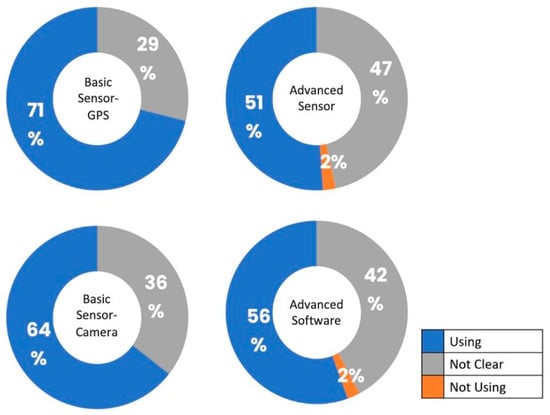
Figure 6.
Percentage of other systems using advanced/basic sensors and software [9].
The functional architecture of the D4S is illustrated in Figure 7 and mainly includes four components: the drone or UAV part, a wireless communication channel, ground control, and a remote command-and-control center. Such a functional architecture enables enhanced situational awareness for dynamic decision making for safety and security personnel by transmitting captured video images, location data, and other telematic data from sensors in real time to the ground control center in the B-D4S version of the system and the CCC in the A-D4S version. The received video image and telematic data, along with the location data, will be plotted on a GIS map. For the CCC, which is mainly part of the A-D4S version of the system, specialized databases specific to each type of operation and AI decision support systems (AI-DSSs) can provide safety and security personnel with extra assistance, enabling better situational awareness and dynamic decision making involving both human and machine elements.

Figure 7.
D4S functional architecture [authors].
2.3. Basic-D4S
2.3.1. B-D4S Architecture
As can be seen from Figure 8 and Table 3, the B-D4S adopts a simple format to foster and facilitate the adaption of drones/UAVs by safety and security organizations with minimal costs, training, and levels of internal and external approval for use and with relatively easy operation in real-life deployments. Organizational management can easily undertake initiatives to modernize, digitally transform, and integrate a new system in service within the applicable national UAV regularly framework.
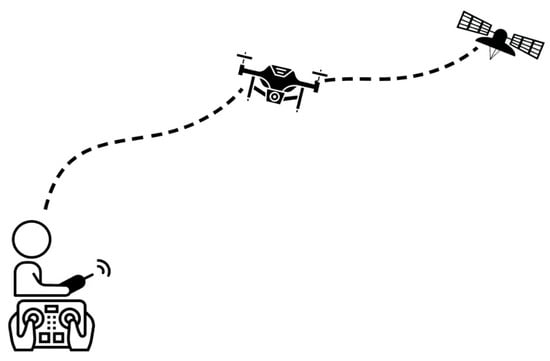
Figure 8.
B-D4S architecture [authors].

Table 3.
Basic-D4S requirements [authors].
2.3.2. B-D4S Operation Concept
Safety and security professionals with appropriate training can operate registered drones with appropriate situational awareness, risk assessment, and observance of operation regulations. The drone can take off to start surveillance operations while the pilot maintains operational safety within line-of-sight (LOS) conditions. The received video stream can be used to support dynamic decision making. Once the task is accomplished, the drone can be called back, and further procedures can be followed. This will enable the introduction of the drone system as part of the standard equipment for safety and security personnel, allowing them to conduct their missions in a safe and effective manner while saving time and resources.
2.4. A-D4S
2.4.1. A-D4S Architecture
This version of the system supports much more advanced and sophisticated operations. As can be seen from Figure 9 and Table 4, the system can be operated according to LOS and non-LOS to extend the range of potential operations. To achieve this, the system needs to include special vehicle equipment with sensors, long-range communication links, a command-and-control center with database access, and an AI algorithm to support human and machine decision making. Therefore, before introducing the system in service, it is important that the right regulatory framework is in place, with a high level of collaboration between different authorities, to make sure that the system can share airspace in a safe and effective manner to achieve the intended propose of use. In addition, the right level of training is needed to achieve the appropriate execution of all professionals’ roles during system operation.

Figure 9.
A-D4S architecture [authors].

Table 4.
A-D4S suggested requirements [authors].
2.4.2. A-D4S Operation Concept
Drone vehicles are typically kept at base or mobile petrol reserves, equipped with a secure communication channel using a mobile or satellite or detected communication infrastructure. Once approval for an operation is given, a drone can take off within LOS or/and beyond LOS (BLOS) conditions and start surveillance, while the command-and-control center can maintain high levels of vigilance concerning the drone’s location and altitude, issuing appropriate commands related to the operation. While other members of the command-and-control center observe the received video stream, data and suggestions from AI can establish better situational or environmental awareness during monitoring to establish and facilitate decisions. Once the event is finished, the drone can be called back to be rechecked for the next operation.
3. Results
3.1. Prototype
An off-the-shelf drone was used for the prototype to benchmark the system requirements with the specification data sheet, as shown in Table 5, to make sure it satisfied the pertinent requirements.

Table 5.
Benchmarking the system prototype requirements [authors]. ✔ mean it portable (tick) as the rest.
The B-D4S prototype (Figure 10) was established and successfully deployed and tested with Qatar Traffic Police. The prototype included an off-the-shelf drone, DJI Air 2S [35], with GPS and surveillance cameras of 5.4 K resolution, a take-off/landing pad on the roof of a traffic police patrol car, and a control joystick with the video stream displayed on a monitor fixed on the car’s dashboard.
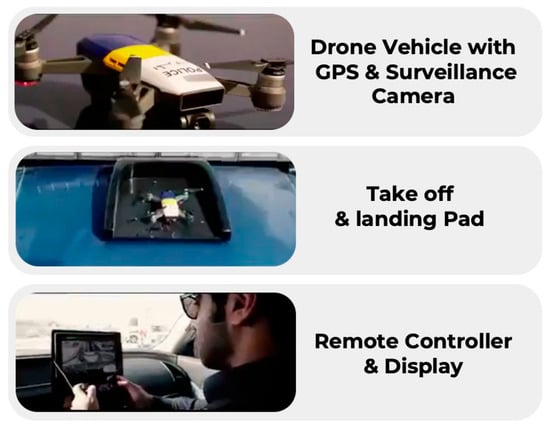
Figure 10.
B-D4S prototype [authors].
3.2. Test Mission
To test the effectiveness of the system in a real-life operation, a mission emulating helicopter surveillance to monitor a traffic situation was performed, as shown in Figure 11, which illustrates a police officer on the ground requesting a drone to establish better situational awareness of the current traffic from a mobile patrol car equipped with a drone surveillance system. Approval and dispatch of the drone to the requested area were obtained, and the video stream of the monitored environment was displayed on the car patrol monitor. Information about the environment was relayed back to the officer on the ground to facilitate decisions about necessary actions. After the mission was accomplished, the drone was recalled back to the traffic police patrol car.
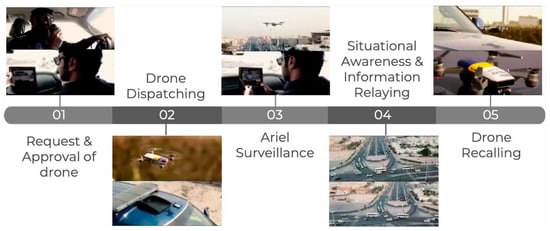
Figure 11.
B-D4S evaluation test [authors].
Evaluation of the operational framework and system architecture was conducted by key stakeholders in order to obtain their feedback on the proposed framework and to make sure that it will tackle most of the issues required for the deployment of drone applications in Qatar, which does not currently have a framework for this kind of technology. The second evaluation was conducted by a consortium of 70 security experts with no previous experience of using such a system to assess whether the proposed architecture is achievable to be deployed within Qatar in particular and other countries in general, considering drone use for safety and security applications. Such evaluation extends beyond technical performance issues to include consideration of end-user safety to facilitate real-life deployment and acceptability among users and the general public related to the TAM.
3.3. Protype Evaluation Analysis
This section presents the deployment of the TAM to evaluate end users’ attitudes towards D4S adoption, using the prototype for B-D4S, based on the previously presented Table 1. Table 1 outlines the construct items defined to test the study hypotheses, aiming to identify the relationships between PU, PeoU, BI2U, and usage for the proposed system.
Cronbach’s alpha coefficients, which measure the internal consistency or reliability of survey items, were used to ensure the stability of the study tool [36,37]. The values for each construct are shown in the Table 6. All values were higher than 0.7, which indicates that the study tool is valid for research purposes.

Table 6.
Cronbach’s alpha coefficients for studied constructs [authors].
Pearson correlation coefficients [38], which measure linear correlations between two sets of data, were used to test the study hypotheses, as shown in Table 7. Figure 12 also shows the results and the related p-values based on the adopted research model. Table 8 summarizes the results for each of the five hypotheses of the study, showing that all five hypotheses were supported.

Table 7.
Pearson correlation of constructs [authors].

Figure 12.
Research model with correlations [authors].

Table 8.
Hypothesis results [authors].
4. Discussion
The primary aim of this research was to enhance situational awareness and enable dynamic decision making or decision support systems in the safety and security sector through the utilization of a proposed drone surveillance system. However, the potential applications of the proposed D4S extend beyond this specific field, offering advantages for similar applications and sectors as well. Two robust system architectures utilizing different sets of sensors have been proposed, and the feasibility of a system prototype has been thoroughly assessed by involving safety and security professionals, deploying commercially available drones in Qatar, and evaluating the acceptability of the technology (as per the identified dimensions of the TAM).
The outcomes of the evaluation strongly favored the proposed systems, confirming their significant value for various stakeholders interested in deploying this cutting-edge technology in real-life scenarios (e.g., traffic management). The D4S represents a crucial step towards revolutionizing safety and security practices, elevating situational awareness to new heights, and empowering decision makers with more informed and timely responses in critical situations.
Despite the promising results, it is essential to acknowledge that this research work is not without limitations. The prototype evaluation was exclusively conducted within the safety and security sector, prompting the need to further assess the system’s benefits across different settings to fully explore its potential for various safety and security applications. By addressing these limitations and conducting more comprehensive evaluations, the D4S has the potential to make substantial contributions to enhancing safety and security measures, paving the way for advancements in the field of drone-based systems.
The D4S represents a crucial step towards revolutionizing safety and security practices, elevating situational awareness to new heights, and empowering decision makers with more informed and timely responses in critical situations.
Author Contributions
Conceptualization, K.A.-D. and Z.H.; methodology, K.A.-D. and Z.H.; investigation, K.A.-D. and Z.H.; writing—original draft preparation, K.A.-D.; writing—review and editing, Z.H.; supervision, W.B. All authors have read and agreed to the published version of the manuscript.
Funding
This research received no external funding.
Institutional Review Board Statement
Not applicable.
Informed Consent Statement
Not applicable.
Data Availability Statement
The data presented in the study are available on request from the corresponding author due to privacy.
Conflicts of Interest
The authors declare no conflicts of interest.
References
- Telli, K.; Kraa, O.; Himeur, Y.; Ouamane, A.; Boumehraz, M.; Atalla, S.; Mansoor, W. A Comprehensive Review of Recent Research Trends on Unmanned Aerial Vehicles (UAVs). Systems 2023, 11, 400. [Google Scholar] [CrossRef]
- Manrique, D.A.; Müller, C.T.; Mellado-Bataller, I. Drones for Search and Rescue Missions: A Survey. J. Intell. Rob. Syst. 2017, 88, 183–202. [Google Scholar]
- Nandi, A.; Zhang, T.; Larcher, A. A Review on Agricultural Drones and Their Applications. Comput. Electron. Agric. 2020, 174, 105507. [Google Scholar] [CrossRef]
- Soh, Y.M.; Ngo, T.T.; Yang, W. A Survey on Drone Delivery Systems. Electronics 2020, 9, 470. [Google Scholar] [CrossRef]
- Tran, K.N.; Shen, X. A Survey on Drone Applications: Security and Privacy Issues and Challenges. IEEE Commun. Surv. Tutorials 2019, 21, 2333–2360. [Google Scholar]
- Unmanned Aircraft Systems (UAS). Available online: https://www.faa.gov/uas/ (accessed on 30 August 2023).
- Al-Dosari, K.; Hunaiti, Z.; Balachandran, W. A Review of Civilian Drones’ Systems, Applications, Benefits, Safety, and Security Challenges. In The Effect of Information Technology on Business and Marketing Intelligence Systems; Alshurideh, M., Al Kurdi, B., Masa’deh, R., Salloum, S.A., Eds.; Springer International Publishing: Cham, Switzerland, 2023; pp. 793–812. [Google Scholar] [CrossRef]
- AL-Dosari, K.; Hunaiti, Z.; Balachandran, W. Civilian UAV Deployment Framework in Qatar. Drones 2023, 7, 46. [Google Scholar] [CrossRef]
- AL-Dosari, K.; Hunaiti, Z.; Balachandran, W. Systematic Review on Civilian Drones in Safety and Security Applications. Drones 2023, 7, 210. [Google Scholar] [CrossRef]
- Citroni, R.; Di Paolo, F.; Livreri, P. A Novel Energy Harvester for Powering Small UAVs: Performance Analysis, Model Validation and Flight Results. Sensors 2019, 19, 1771. [Google Scholar] [CrossRef]
- Abro, G.E.M.; Zulkifli, S.A.B.M.; Masood, R.J.; Asirvadam, V.S.; Laouti, A. Comprehensive Review of UAV Detection, Security, and Communication Advancements to Prevent Threats. Drones 2022, 6, 284. [Google Scholar] [CrossRef]
- Al-Dosari, K.; Hunaiti, Z.; Balachandran, W. Mega Sporting Event Scenario Analysis and Drone Camera Surveillance Impacts on Command-and-Control Centre Situational Awareness for Dynamic Decision-Making. Safety 2023, 9, 54. [Google Scholar] [CrossRef]
- Kramer, M. Best Practices in Systems Development Lifecycle: An Analyses Based on the Waterfall Model. Rev. Bus. Financ. Stud. 2018, 9, 77–84. [Google Scholar]
- Alshamrani, A.; Bahattab, A. A Comparison Between Three SDLC Models: Waterfall Model, Spiral Model, and Incremental/Iterative Model. Int. J. Comput. Sci. Issues 2015, 12, 106–111. [Google Scholar]
- Marangunić, N.; Granić, A. Technology Acceptance Model: A Literature Review from 1986 to 2013. Univers. Access Inf. Soc. 2015, 14, 81–95. [Google Scholar] [CrossRef]
- Davis, F.D. User Acceptance of Information Technology: System Characteristics, User Perceptions and Behavioral Impacts. Int. J. Man Mach. Stud. 1993, 38, 475–487. [Google Scholar] [CrossRef]
- Rigopoulos, G.; Psarras, J.; Askounis, D. A TAM Model to Evaluate User’s Attitude Towards Adoption of Decision Support Systems. J. Appl. Sci. 2008, 8, 899–902. [Google Scholar] [CrossRef]
- Money, W.; Turner, A. Application of the Technology Acceptance Model to a Knowledge Management System. In Proceedings of the 37th Annual Hawaii International Conference on System Sciences, Big Island, HI, USA, 5–8 January 2004; IEEE: New York, NY, USA, 2004; Volume 9. [Google Scholar] [CrossRef]
- Pressman, R.S. Software Engineering: A Practitioner’s Approach; McGraw-Hill Education: New York, NY, USA, 2014; ISBN 978-0078022128. [Google Scholar]
- Bello, A.B.; Navarro, F.; Raposo, J.; Miranda, M.; Zazo, A.; Álvarez, M. Fixed-wing UAV Flight Operation Under Harsh Weather Conditions: A Case Study in Livingston Island Glaciers, Antarctica. Drones 2022, 6, 384. [Google Scholar] [CrossRef]
- Javaid, A.Y.; Sun, W.; Devabhaktuni, V.K.; Alam, M. Cyber Security Threat Analysis and Modeling of an Unmanned Aerial Vehicle System. In Proceedings of the 2012 IEEE Conference on Technologies for Homeland Security (HST), Waltham, MA, USA, 13–15 November 2012; IEEE: New York, NY, USA, 2012; pp. 585–590. [Google Scholar] [CrossRef]
- Haque, S.R.; Kormokar, R.; Zaman, A.U. Drone Ground Control Station with Enhanced Safety Features. In Proceedings of the 2017 2nd International Conference for Convergence in Technology (I2CT), Mumbai, India, 7–9 April 2017; IEEE: New York, NY, USA, 2017; pp. 1207–1210. [Google Scholar] [CrossRef]
- Mohsan, S.A.H.; Khan, M.A.; Noor, F.; Ullah, I.; Alsharif, M.H. Towards the Unmanned Aerial Vehicles (UAVs): A Comprehensive Review. Drones 2022, 6, 147. [Google Scholar] [CrossRef]
- Ali, H.; Hang, L.Y.; Suan, T.Y.; Polaiah, V.R.; Aluwi, M.I.F.; Zabidi, A.M.; Elshaikh, M. Development of Surveillance Drone Based Internet of Things (IoT) for Industrial Security Applications. J. Phys. Conf. Ser. 2021, 2107, 012018. [Google Scholar] [CrossRef]
- Dilshad, N.; Hwang, J.; Song, J.; Sung, N. Applications and Challenges in Video Surveillance Via Drone: A Brief Survey. In Proceedings of the 2020 International Conference on Information and Communication Technology Convergence (ICTC), Jeju, Republic of Korea, 21–23 October 2020; IEEE: New York, NY, USA, 2020; pp. 728–732. [Google Scholar] [CrossRef]
- Lahmeri, M.A.; Kishk, M.A.; Alouini, M.S. Charging Techniques for UAV-assisted Data Collection: Is Laser Power Beaming the Answer? IEEE Commun. Mag. 2022, 60, 50–56. [Google Scholar] [CrossRef]
- Fahlstrom, P.G.; Gleason, T.J.; Sadraey, M.H. Introduction to UAV Systems, 5th ed.; John Wiley & Sons: London, UK, 2022; ISBN 978-1119802617. [Google Scholar]
- Hosseini, N.; Jamal, H.; Haque, J.; Magesacher, T.; Matolak, D.W. UAV Command and Control, Navigation and Surveillance: A Review of Potential 5G and Satellite Systems. In Proceedings of the 2019 IEEE Aerospace Conference, Big Sky, MT, USA, 2–9 March 2019; IEEE: New York, NY, USA, 2019; pp. 1–10. [Google Scholar] [CrossRef]
- Cezar, P.O.P.A.; Mitulețu, I. State-of-the-art Technologies to be Used in Command and Control Systems. Bull. Carol I Natl. Def. Univ. 2021, 10, 54–63. [Google Scholar] [CrossRef]
- Burke, C.; McWhirter, P.R.; Veitch-Michaelis, J.; McAree, O.; Pointon, H.A.; Wich, S.; Longmore, S. Requirements and Limitations of Thermal Drones for Effective Search and Rescue in Marine and Coastal Areas. Drones 2019, 3, 78. [Google Scholar] [CrossRef]
- Wang, S.; Jiang, F.; Zhang, B.; Ma, R.; Hao, Q. Development of UAV-based Target Tracking and Recognition Systems. IEEE Trans. Intell. Transp. Syst. 2019, 21, 3409–3422. [Google Scholar] [CrossRef]
- Eckstrom, D.R. Facial Recognition Software for Patrol. White Paper, Arlington Police Department. 2020. Available online: https://shsu-ir.tdl.org/server/api/core/bitstreams/0dd66bae-5f31-44f6-af51-ea19737d2641/content (accessed on 20 August 2023).
- Rigano, C. Using Artificial Intelligence to Address Criminal Justice Needs. Nat. Inst. Justice J. 2019, 280, 17. [Google Scholar]
- Pranav, D.S.; Dubey, T.; Singh, J. A Literature Review: Artificial Intelligence in Public Security and Safety. EasyChair 2020; Preprint no. 4578. Available online: https://easychair.org/publications/preprint/KHQL (accessed on 30 August 2023).
- Hopper, D. DJI Air 2S. Aust. Photogr. 2021, 62–64. Available online: https://www.dji.com/uk/air-2s (accessed on 20 August 2023).
- Ko, Y.; Kim, J.; Duguma, D.G.; Astillo, P.V.; You, I.; Pau, G. Drone Secure Communication Protocol for Future Sensitive Applications in Military Zone. Sensors 2021, 21, 2057. [Google Scholar] [CrossRef] [PubMed]
- McNeish, D.M. Thanks Coefficient Alpha, We’ll Take It from Here. Psychol. Methods 2017, 23, 412–433. [Google Scholar] [CrossRef] [PubMed]
- Atmanspacher, H.; Martin, M. Correlations and How to Interpret Them. Information 2019, 10, 272. [Google Scholar] [CrossRef]
Disclaimer/Publisher’s Note: The statements, opinions and data contained in all publications are solely those of the individual author(s) and contributor(s) and not of MDPI and/or the editor(s). MDPI and/or the editor(s) disclaim responsibility for any injury to people or property resulting from any ideas, methods, instructions or products referred to in the content. |
© 2024 by the authors. Licensee MDPI, Basel, Switzerland. This article is an open access article distributed under the terms and conditions of the Creative Commons Attribution (CC BY) license (https://creativecommons.org/licenses/by/4.0/).